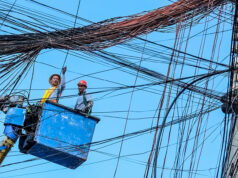Unemployment rate hits record high in 2020

LAST YEAR proved to be challenging for the labor market as many Filipinos became jobless with businesses closing or downsizing operations amid the coronavirus pandemic.
Preliminary results of the statistics authority’s 2020 Annual Labor and Employment Estimates based on the average of four rounds of the labor force survey (LFS), showed the labor force participation rate (LFPR) stood at 59.5% in 2020, lower than the 61.3% in 2019. This rate is equivalent to 43.9 million Filipinos out of the 73.7 million population 15 years old and over.
LFPR represents the country’s “economically active population” that are either employed or unemployed.
“This annual LFPR is lowest since the adoption of the new definition of unemployed in April 2005, reflecting the effect of the various community quarantine restrictions, business closures, and physical distancing measures that were put in place in the Philippines starting March 2020 amidst the coronavirus disease 2019 (COVID-19) pandemic,” the Philippine Statistics Authority (PSA) said in a statement.
The annual unemployment rate in 2020 reached a record-high 10.3% versus the 5.1% in 2019. This is equivalent to 4.5 million Filipinos who do not have jobs, but are looking for one.
Meanwhile, the underemployment rate or the proportion of those working but are looking for more work or longer working hours, increased to 16.2% (or 6.4 million) from 13.8% the previous year.
The employment rate, which is the proportion of the employed to the total labor force, likewise declined to 89.7% from 94.9% previously. This translates to around 39.4 million employed, from 41.9 million the year before.
This equates to a net job loss of 2.6 million last year versus the government’s annual target of 900,000 to 1.1 million.
Meanwhile, the 10.3% unemployment rate this year is way above the 3.8%-5.2% target set in the Philippine Development Plan 2017-2022 for this year.
Of the four LFS rounds, the largest negative readings were recorded in April with unemployment and underemployment reaching as high as 17.6% and 18.9% during that month. Similarly, the employment rate and LFPR shrank to as low as 82.4% and 55.7%.
The services sector accounted for the biggest proportion of the employed population with a 56.9% share in 2020, down from 58.4% a year earlier. Industry accounted for 18.3%, also down from 19.3% in 2019. On the other hand, the share of those employed in the agriculture sector increased to 24.8% from 22.2%.
Wage and salary workers accounted for 62.9% of the workforce in 2020 from 64.6% in 2019. Employers in their own family-operated business likewise dipped to 2.5% from 2.9%. On the other hand, the share of self-employed individuals without any paid employees and unpaid family workers went up to 28.3% (from 26.8%) and 6.3% (from 5.7%), respectively.
Working hours averaged 39.4 per week in 2020, down from 42.2 a year earlier.
Full-time workers, or those who worked for at least 40 hours in a week, shrank to 55.9% from 69.3%. Part-time workers accounted for 34.5% of employed persons from 29.9%.
The results were not surprising for UnionBank of the Philippines, Inc. Chief Economist Ruben Carlo O. Asuncion. “[T]he employment story was the hardest part in 2020,” he said in an e-mail.
Asked on how to address the current conditions in the labor market, Mr. Asuncion cited “more fiscal support” from the government, as well as assistance for the country’s micro, small, and medium enterprises as they employ around 60% of working Filipinos.
“I am expecting things to get better. As the economy continues to open up, more job opportunities will come back,” Mr. Asuncion said.
The lockdown restrictions imposed by the government to contain COVID-19 severely constricted economic activity. For 2020, the Philippine economy posted a record-high annual decline of 9.5%, peaking at 16.9% in the second quarter before decelerating to 8.3% contraction in the final three months of the year.
The country’s economic planners had been urging President Rodrigo R. Duterte to relax lockdown restrictions to boost consumption and stimulate economic growth.
The country began its COVID-19 vaccination program on March 1, with health workers inoculated with vaccines donated by China. The government is targeting to inoculate 70 million, but the delivery of other vaccines has been delayed. — Ana Olivia A. Tirona



